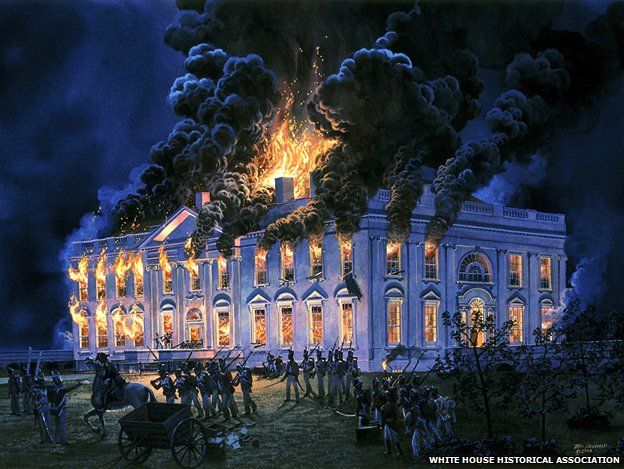The odd objects looted from Washington DC in 1814
- Published

It's been 200 years since the British burned Washington, but objects looted in 1814 will probably never be returned, writes Tammy Thueringer.
Other than an off-colour tweet and subsequent apology by the British Embassy, the bicentennial of the punitive mission of 1814 that left the US capital in flames has received little attention this week.
The burning was one of the final events of the often-forgotten War of 1812, a conflict which saw the US try and fail to grab bits of Canada and Britain try and fail to blockade the US. British troops torched the White House, Treasury and parts of the Capitol Building in a punitive mission near the end of the war. They also looted what they could, effectively collecting "souvenirs".
After the attack, the Royal Navy sailed to Bermuda with their spoils, included four paintings of King George III and Queen Charlotte, a grandfather clock and President James Madison's personal government receipt book.
Today, the artworks hang in two Bermuda government buildings and the clock is in private hands.
The destruction of Washington was in retaliation for an earlier US attack on the Parliament of Lower Canada at York (now Toronto). The US also looted, taking a royal standard, the first Mace of Ontario, a golden staff used by Upper Canada's Parliament, and a lion statuette, carved out of wood and painted gold.
Today, the standard and lion are just two of the hundreds of "trophies of war" on display at the US Naval Academy in Annapolis, Maryland.
The "trophies" in Bermuda and Maryland will probably stay there, at least in part because of the American Civil War-era "Lieber Code". The US declared that items captured from an enemy in time of war can be kept. The laws only applied to American forces, but other states adopted similar regulations.
Since then, several international laws prohibiting wartime looting have been created, but the original code also remains in effect.
Despite that original code, some of the looted items have made it home.
In 1934, President Franklin Roosevelt ordered the return of the mace and Madison's receipt book was returned to the Library of Congress in 1940.
But as for the paintings of the British royals, the Americans seem unlikely to press for their return.
Subscribe to the BBC News Magazine's email newsletter to get articles sent to your inbox.